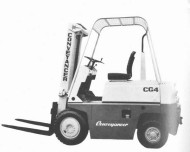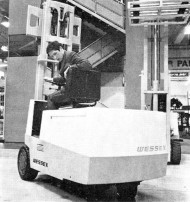 We have now reached the fifty fourth instalment in our exclusive series on the history of the fork lift truck, the machine that over the decades has revolutionised the face of materials handling around the world. In this episode we’re up to 1968, the year of the first supersonic airliner.
We have now reached the fifty fourth instalment in our exclusive series on the history of the fork lift truck, the machine that over the decades has revolutionised the face of materials handling around the world. In this episode we’re up to 1968, the year of the first supersonic airliner.
Our writer is James Brindley, an acknowledged authority on fork lift trucks. James’s distinguished career has involved engineering and management roles with BT Rolatruc and serving as a Director of the Fork Lift Truck Association, before he set up the National Fork Truck Heritage Centre in 2004 as Britain’s first such collection open to the public.
The Heritage Centre continues to need your support in 2011, and if you or your company would like to help in any way, you can contact James on the number below. Now sit back and enjoy the latest part of this fascinating series.
Episode 54: 1968 – Fork lift trucks enter the supersonic era
The New Year began with most companies looking forward to May and the 1968 International Mechanical Handling Exhibition. This was the year when the initial flight took place of the first supersonic airliner: the Russian TU-144 and the launch of the low cost Kelvin Barton Minimoke forklift truck. The BMC Minimoke car was originally designed as a 60s cult vehicle, but here it was fitted with a 5 cwt capacity Kelvin mast and adapted for work in a Kent fruit orchard. Various attachments were available and for an increased lifting capacity to 10 cwt a similar truck was available that was based on a Land Rover chassis.
 On to more conventional machines but with updated design was the new battery powered range by the Wessex Company. Lifting capacities from 8,000lbs to 20,000lbs as models FE 80/100/120/130/140/160 and FE 200 were offered to the customer as standard equipment. All but two had SCR control and power assisted steering as standard. These were the FE 80 and the FE 100, which were fitted with carbon pile controllers although SCR was available as an optional feature.
On to more conventional machines but with updated design was the new battery powered range by the Wessex Company. Lifting capacities from 8,000lbs to 20,000lbs as models FE 80/100/120/130/140/160 and FE 200 were offered to the customer as standard equipment. All but two had SCR control and power assisted steering as standard. These were the FE 80 and the FE 100, which were fitted with carbon pile controllers although SCR was available as an optional feature.
This was also the year when the Conveyancer Company shone with its newly designed ‘Starline’ range of trucks. These machines were easily identifiable from the embossed red star on the mast head bracket. The counterbalance range included battery powered machines from 2,000lb to 8,000lb capacity and I/C engined machines which were rated from 4,000lb to 8,000lb. As an additional feature the makers claimed that the machines had a high degree of standardization and interchangability of components.
Among the new equipment displayed at the exhibition was a 3,000lb lift, battery powered counterbalance introduced by the Matling Company. The drive module incorporated the Langdale Hydrostatic Transmission System and was incorporated to replace the perceived complication of the electronic controls which were at this time being used by many of the forklift manufacturers. The main characteristics of this compact, hub mounted system were an infinitely variable speed drive and an excellent braking capability. Motor controls for the whole machine were executed by two solenoids, one for lifting and the other for the drive. An interesting feature using the Langdale drive was the elimination of the conventional steering wheel. This was replaced by two levers, with directional turns being regulated by pulling on the one on the right or the left. Braking was operated by pulling on both levers simultaneously. The machine displayed gave a lifting capacity of 3,000lbs to 10 feet.
This year’s exhibition contained many more larger and more powerful machines than ever before. The trend to larger machines was no doubt brought about by the growth in containerization and a need by the timber and iron and steel industries to handle the more economic larger loads. Two companies that seemed to have anticipated the market were Lancer Boss with their new 3,500 series truck and Joshua Shaw with their Shawloader 560C. The Lancer Boss sideloader, with a top lift attachment, could lift loaded 30 and 40ft containers two-high. Power was supplied by a 380 bhp Cummins diesel engine. An added feature was a self elevating cab to aid driver visibility during handling or when travelling with a container on the platform.
By James Brindley, Director, National Fork Truck Heritage Centre.
To be continued…
If you would like to support the National Fork Truck Heritage Centre, please call James Brindley on 0780 195 4167




Comments are closed.